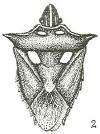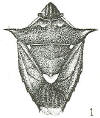 |
|
Aspavia Stål, 1865
Aspavia Stål, 1865: 60, 82.
Type Species: Cimex armiger Fabricius, 1781, by subsequent designation (Kirkaldy, 1909).
Diagnosis:
Tribal Placement: Interestingly, Stål (1865) treated a number of genera as subgenera of Pentatoma. These included (in order of appearance): Eysarcoris, Aspavia, Carbula, Durmia, Ilipla, Veterna, Cappaea, Caura, Ilerida, Theloris, and Aeliomorpha. In 1876, Stål in his key to genera, indicated groupings of related genera. He included Sepontia with Eysarcoris in his "Eysarcocoris et affinia," and in his "Aspavia et affinia" he included Aspavia, Carbula, Durmia, and Ilipla. But he had the eysarcorines key out right next to the Aspavia group, thus indicating a possible relationship. Cachan (1952) treated these genera as members of the Carpocorini, but his view of the Carpocorini was quite broad. In fact, he treated these genera between Eysarcoris and Corisseura, both members of the Eysarcorini. Linnavuori (1982) treated them in their own group (the Carbula group), but indicated that they and the Eysarcorini were probably both derivatives of the Diploxys group. Because no one has given this group of genera a tribal name, and there is some evidence that they may be related to the eysarcorines, I consider Aspavia to be a member of the Eysarcorini. This may change when a formal phylogenetic analysis is completed.
Included Species:
acuminata Montandon, 1894
albidomaculata Stål, 1853
armigera (Fabricius, 1781)
brunnea (Signoret, 1858)
grandiuscula Distant, 1881
hastator (Fabricius, 1794)
inermis Linnavuori, 1986
inficita (Walker, 1867)
ingens Distant, 1890
longispina (Stål, 1865)
nigricosta Montandon, 1894
pallidispina (Stål, 1865)
speciosa Schouteden, 1958
vittiventris argutidens Linnavuori, 1975
vittiventris vittiventris Lethierry, 1881
Key to Species (modified from Linnavuori, 1982)
|
1 Scutellum with Y-shaped pale callose figure |
2 |
|
- Scutellum different |
3 |
|
2(1) Apex of each femur provided with a small, sharp spine (Guinean) |
brunnea (Signoret) |
|
- Apex of each femur edentate (Congo, Rwanda) |
speciosa Schouteden |
|
3(1) Basal callosities of scutellum very reduced; apex of scutellum densely punctate with brown (Guinean east to Kenya) |
hastator (Fabricius) |
|
- Basal scutellar callosities distinct; apex of scutellum pale callose, impunctate |
4 |
|
|
|
|
4(3) Apex of each femur edentate (Cameroon) |
inermis Linnavuori |
|
- Apex of each femur provided with a small, sharp spine |
5 |
|
|
|
|
5(4) Basal callosities of scutellum fairly small, distinctly narrower than distance from their inner margin to midline of disk; head with pale impunctate longitudinal stripes |
6 |
|
- Basal scutellar callosities very large, broader than distance from their inner margin to midline; pale stripes on head less distinct |
9 |
|
|
|
|
6(5) Humeral spines of pronotum black |
armigera (Fabricius) |
| - Humeral spines of pronotum pale | 7 |
|
7(6) Abdominal venter with three broad longitudinal black bands |
8 |
|
- Dark lines on venter only faintly indicated |
pallidispina (Stål) |
|
|
|
|
8(7) Madagascar, Mauritius |
longispina (Stål) |
|
- Mainland Africa |
vittiventris Lethierry |
|
|
|
|
9(5) Antennae very long and gracile, black, with only first joint pale |
ingens Distant |
| - Antennae more or less pale throughout | 10 |
|
10(9) Basal scutellar callosities narrowly ovate; pale callose band between humeral angles of pronotum |
grandiuscula Distant |
|
- Basal scutellar callosities roundedly squarish; no pale transverse band on pronotum |
11 |
|
|
|
|
11(10) Humeral spines of pronotum long, acute, distinctly recurved dorsad (seen from behind); body more elongate; scutellum narrowish; spines of last paratergite more acute; spiracles black |
acuminata Montandon |
|
- Humeral spines of pronotum shorter, nearly horizontal; body less elongate; scutellum broader; spines of last paratergite blunter, spiracles brown |
albidomaculata (Stål) |
Comments: The key above, modified from Linnavuori (1982), will identify most species. Missing from this key are the following taxa: inficita, and nigricosta. Walker (1867) described inficita as being similar to armigera except that the basal scutellar spots are somewhat larger, the humeral spines are a little stouter, and there are two dark longitudinal stripes on the abdominal venter. These are characteristics that match very well with A. albidomaculata; I believe the two are probably synonyms (both occur in southern Africa). Montandon (1894) also describes nigricosta from southern Africa, and relates it to albidomaculata. Only a study of the type material will help determine if these taxa are all valid.
Also, the species longispina appears to be very close to vittiventris; both have relatively small pale callouses on the base of the scutellum, the humeral spines are brownish (not black), and they have three longitudinal dark stripes on the abdominal venter. Aspavia longispina is only known from Madagascar and Mauritius, while vittiventris is more widespread in eastern and northeastern Africa.
| Researchers | Genus Index | Systematics | Host Information |
| Bibliography | Species Index | Biographies & Type Info | Natural Enemies |
| Catalogs | Identifications | Collection Lists | Other resources |
David A. Rider
Associate Professor of Entomology
North Dakota State University
202 Hultz Hall
Fargo, ND 58105
E-Mail: David.Rider@ndsu.nodak.edu
Published by the Department of
Entomology
Prospective students may schedule a visit by calling 1-800-488-NDSU.

